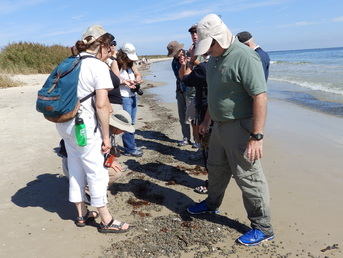This month’s featured volunteer project has educated more than 13,000 youths and adults since its inception seven years ago. Volunteer Clyde Marsteller (Historic Rivers Chapter) authored this retrospective on the project he nurtured since 2007.
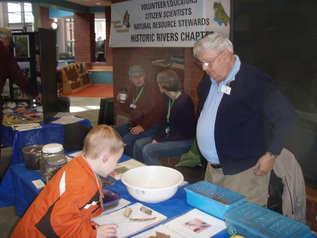 At schools, festivals, and community events, VMN volunteer Clyde Marsteller introduces children to the amazing creatures that may live in their own backyards.
At schools, festivals, and community events, VMN volunteer Clyde Marsteller introduces children to the amazing creatures that may live in their own backyards.
By Virginia Master Naturalist volunteer Clyde Marsteller (Historic Rivers Chapter)
“The earth does not belong to man, man belongs to the earth. All things are connected like the blood that unites us all. Man did not weave the web of life, he is merely a strand in it. Whatever he does to the web, he does to himself. If all the animals were gone, man would die of a great loneliness of spirit. For whatever happens to the animals, soon happens to man. All things are connected.” Chef Settle, Chief of the Suquamish Indians from an 1855 letter to President Franklin Pierce
One of my favorite authors is Gerald Durrell, an English naturalist and animal collector. He is the originator of the program that uses zoos as repositories for animals that are in danger of extinction. The ultimate goal was to re-establish breeding populations in their original habitat. Mr. Durrell wrote a book entitled A Zoo In My Luggage about his adventures collecting wild animals and his trials and tribulations attempting to get the animals to England.
For years I envisioned collecting local fauna and bringing a “Zoo in My Luggage” to our schools to share with our children the amazing animals that live in our world with us. After I became a Virginia Master Naturalist volunteer, I realized the course had given me the training, knowledge and tools I needed to put together my “Zoo”. I wanted it to be able to introduce the concepts of stewardship, conservation and ecology of our natural resources and to show the children the beauty of our natural world. I felt, as did Richard Louv, author of the Last Child In The Woods, that our children are addicted to TV and social media and suffer from Nature Deficit Disorder.
Our ecology training gave me the final piece to solve my puzzle, and I started my zoo by investigating the ecology of an “Isabel Log” — a decaying tree trunk leftover from the hurricane that visited our area 11 years ago. Hurricane Isabel knocked down an estimated one million trees in Virginia. During my master naturalist class geology field trip to local vernal ponds, I learned that our peninsula has been forested for at least 24,000 years, which caused me to wonder how nature recycled those tens of thousands of years of storm-downed trees and fallen leaves.
My church, St Georges Episcopal in Newport News, has three acres of suburban woodland habitat containing numerous hardwoods averaging 50 to 70 feet in height with minimal understory growth. Isabel blew over many oaks, maples, sweet gums and loblolly pines in the church woods and cleanup crews left numerous sawed logs along with uprooted root systems on the forest floor.
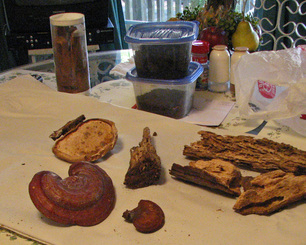 Clyde collected invertebrates from wooded areas in his community.
Clyde collected invertebrates from wooded areas in his community.
I started collecting for my zoo in the leaf and woods floor ecosystems from what I call “God’s Three Acres” – (G3A). The amount in my small, small world was astounding. I found major groups of animals happily munching on the fallen leaves and mulch. There were Isopods (roly polies), millipedes, slugs, snails, worms. Next I examined the Isabel logs. I collected lichen, bracket fungi, mushrooms and mosses. The next step involved carefully collecting every animal I could catch. The animals consisted of termites, several species of beetles, ants and centipedes. Very large tunnels were being eaten into the logs by huge Betsy beetles (patent leather beetles), which became my favorite insect. Spiders disappeared into the tunnels along with delicate wood roaches. Occasionally I would uncover a black widow spider. Tiger beetles scurried about. There were darkling beetles, snail eating beetles, click beetles and their larva – the voracious wireworms.
When I turned the logs over, I collected several lead back salamanders, five-lined skinks and common ground skinks. On ensuing trips I added a fence lizard (swift) and a broad-headed skink.
The largest predators I found were several Fowler toads, a leopard frog, and a beautiful box turtle. Finally near a windfall I found the shed skin of the apex predator – a 5-foot black racer snake. Later in the year, I would capture two of its progeny: a beautiful juvenile and a three-foot teenager that was the most aggressive snake I ever met.
Surprisingly, as the year progressed, the animals in this forest floor environment stayed the same. (Of course in the foliage you could find any number of new creatures.) The variety of snakes that lived in and around the logs is amazing. I have collected seven species to date: worm snakes, rough earth snakes, crowne snakes, ring neck snakes, brown (De Kay’s) snakes, green tree snakes, and black racers.
I had to devise homes for animals ranging from small arthropods and gastropods to an assortment of venomous critters, and I had to feed them all. The animals are kept in large jars, Tupper Ware, and plastic jugs that are set up as small terrariums. The reptiles are caught prior to presentations and released back into G3A within a few days.
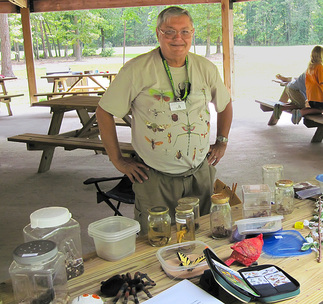 Clyde Marsteller with his “Zoo” at a local park.
Clyde Marsteller with his “Zoo” at a local park.
In order to legally present the Zoo to the public, our chapter had to accept the concept of the Zoo as a volunteer project and then support me by acquiring the three necessary permits from DGIF: Exhibit Permit ($20), Collection Permit ($40), and a Salvage Permit ($60).
Now I was ready to start. I wrote several lesson plans for a variety of audiences. It fast became apparent that I would need assistance, and the chapter responded with what I fondly call my “Zoo Cru”. Without them and the backing of the Historic Rivers Chapter the presentations would have been impossible to do.
The Zoo’s first official appearance was at Poquoson Elementary School in my granddaughter Kayla’s third-grade class. (She was the
first Zoo Cru member.) The Zoo absolutely charmed and fascinated the children.
I originally tailored the Zoo to the third, fourth and fifth grades. Happily it fit perfectly into their SOLs. Since then I have expanded the program to fit any age group K – 12, college and adults. The Zoo has become a sought-after program in five major school districts: James City County, Williamsburg, York County, Poquoson, Newport News and Hampton. And garden clubs, civic organizations, festivals and local community events also host the Zoo.
To see youngsters involved and responding to the animals that share their world and to open their minds to the concepts of stewardship and conservation is one of the most satisfying things I have done.
Has the project had an impact on our communities? The children often write me letters that are eloquent testimonies of the Zoo’s impact. Even more gratifying is to see them involved in their Ecology, Junior Master Gardeners, and 4H Clubs. The epitome is having them run up to me at school functions or at the mall eager to tell me how much they enjoyed our visits and relate stories of what they have experienced outdoors.
Since its inception in 2007, the Zoo has now entertained and educated more than 13,000 children and adults.
On May 21, 2013, I attained a personal goal. I had wanted to honor the 20 children and six adult staff members who were tragically lost at Sandy Hook Elementary School by presenting the Zoo to 26 elementary classes in 2013 – and on this day I gave my 26th presentation of the year.
I feel the Zoo fulfills a belief exposed by one of my heroines – Rachel Carson: “If a child is to keep his/her inborn sense of wonder… he/she needs the companionship of at least one adult who can share it, rediscovering with them the joy, excitement and mystery of the world we live in”.
Clyde has retired as the Head Zookeeper for the Zoo in My Shopping Bags project, but his wonderful work is being continued by another Historic Rivers Master Naturalist volunteer, Catherine Short, and other members of the chapter.
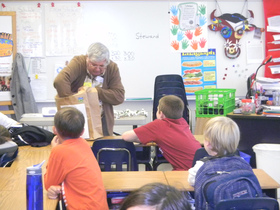
Clyde Marsteller introducing a new classroom to the Zoo. The Zoo has reached more than 13,000 children and adults.






